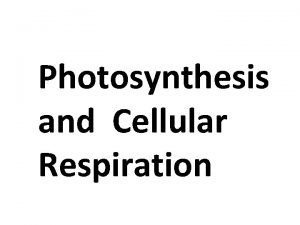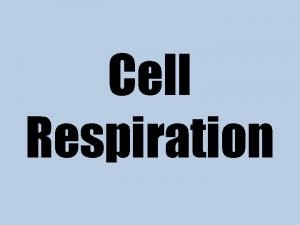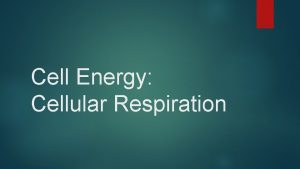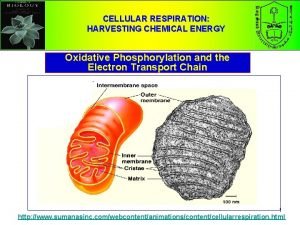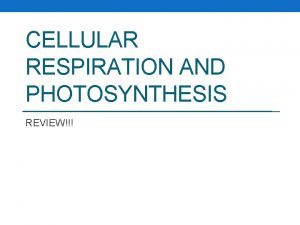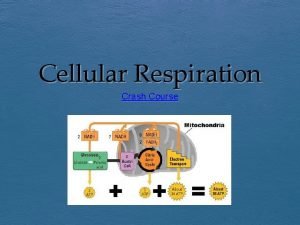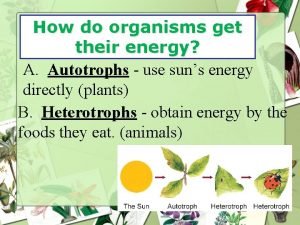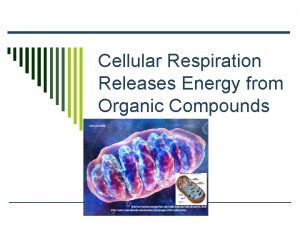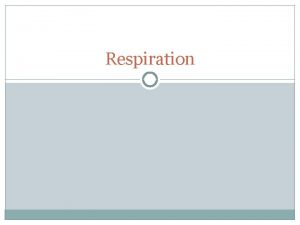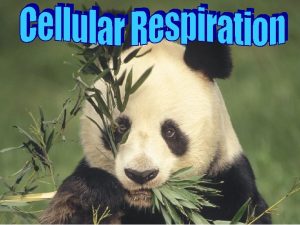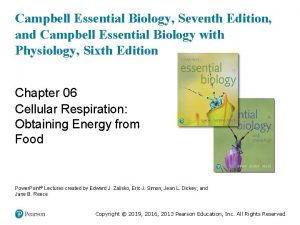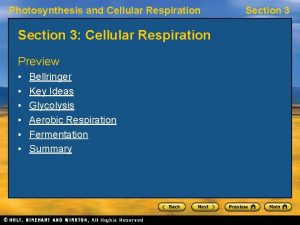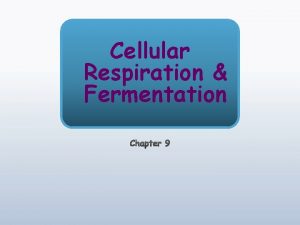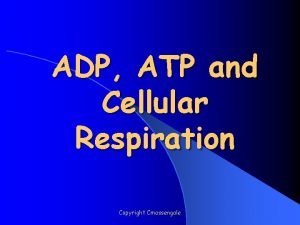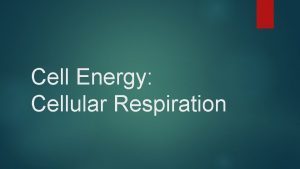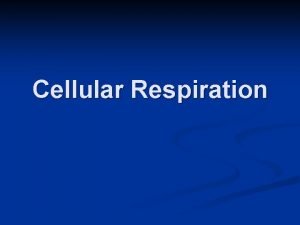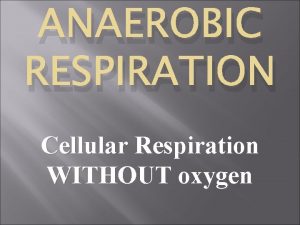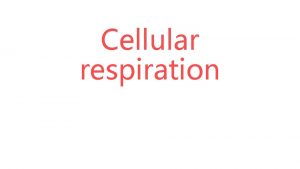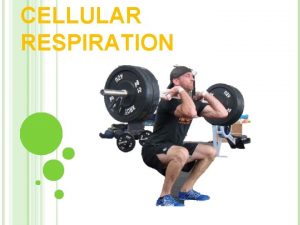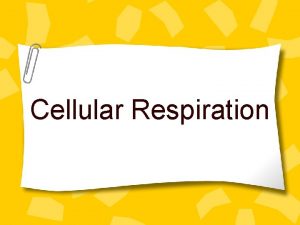Overview of Cellular Respiration Electrons carried via NADH



















- Slides: 19

Overview of Cellular Respiration Electrons carried via NADH GLYCOLYSIS GLUCOSE MITOCHONDRION PYRUVATE KREBS CYCLE ATP Electrons carried via NADH & FADH 2 ELECTRON TRANSPORT CHAIN & OXIDATIVE PHOSPHORYLATION CYTOSOL (substrate level phosphorylation) ATP (oxidative phosphorylation)

Task • Read the learning outcomes on Glycolysis on the next slide • How do you feel? • Where are your gaps?

Learning outcomes: • State that glycolysis occurs in the cytoplasm of cells. • Outline the process of glycolysis beginning with the phosphorylation of glucose to hexose bisphosphate, splitting of hexose bisphosphate into two triose phosphate molecules and further oxidation to pyruvate, producing a small yield of ATP and reduced NAD; • State that, during aerobic respiration in animals, pyruvate is actively transported into mitochondria;

Stage 1: Respiration: Glycolysis Split into 4 stages: 1. Phosphorylation 2. Splitting of the hexose 1, 6 bisphosphate 3. Oxidation of triose phosphate 4. Conversion to pyruvate

Cellular Respiration • Watch. . Good link • http: //highered. mcgrawhill. com/sites/0072507470/student_view 0/chapter 25/animation__how_glycolysis _works. html

Glycolysis – an introduction • Glycolysis means splitting of sugar • Occurs in cytoplasm of all living cells (sarcoplasm of muscle cells) • Stores of glycogen in muscle/liver (SYNOPTIC) a polymer of glucose must first be converted to glucose • GLUCOSE is the main respiratory substrate. • Good fuel but is unstable and unreactive • Glucose, a six carbon sugar is split into two threecarbon sugars – These smaller sugars are then oxidised, and their remaining atoms are rearranged to form two molecules of pyruvate

Stage 1 Phosphorylation • Because glucose is stable and unreactive it needs an input of energy to get the reaction started • 1 ATP molecule is hydrolysed to provide the energy to phosphorylate the glucose molecule at carbon 6 to form glucose 6 -phosphate • This is changed to fructose 6 phosphate • 1 ATP is hydrolysed and attaches to fructose 6 -phosphate at C 1 • This is now fructose 1, 6 bisphosphate

Stage 1 Phosphorylation • The hexose sugar is activated • This prevents it from leaving the cell • Referred to as hexose 1, 6 bisphosphate • Each stage is catalysed by a different enzyme • 2 ATP molecules have been used!

Stage 2: Splitting • Hexose 1, 6 bisphosphate • Split into 2 x triose phosphate

Stage 3: Oxidation • 2 x triose phosphate • Anaerobic BUT 2 hydrogen atoms (with their electrons) are removed from each TP molecule • Dehydrogenase enzymes are involved • Aided by coenzyme NAD • NAD combines with hydrogen atoms and becomes reduced NAD • Produced per glucose molecule : 2 molecules reduced NAD and 2 ATP by substrate level phosphorylation • 2 x intermediate 3 C compounds

Substrate level phosphorylation • The ATP is produced by substrate level phosphorylation • Glucose is at a higher energy level than pyruvate: so energy is used to produce ATP (phosphate from intermediate compounds transferred to ADP)

Stage 4: Conversion to pyruvate • 2 x intermediate 3 C compounds • 4 enzyme-catalysed reactions convert each TP molecule to a molecule of pyruvate (3 C) • In this process 2 x ADP phosphorylated to produce 2 ATP in substrate level phosphorylation.

The end products of glycolysis… • Over this series of reactions 2 ATP are used up • However 4 ATP molecules are created • Therefore there is a net gain of 2 ATP (substrate level phosphorylation) • 2 reduced NAD are also made which will go to the respiratory chain on the inner membrane of the mitochondria and used to generate more ATP during oxidative phosphorylation. • 2 molecules of 3 C pyruvate: actively transported into the mitochondrial matrix for the next stage of aerobic respiration

Pyruvate is actively transported into the matrix of the mitochondria where the Krebs cycle begins… The Matrix

TASKS 1. Using the next slide, ensure you can outline the process of glycolysis 2. Complete the Glycolysis sort (answer on slide 2) 3. What detail can you add? 4. Complete the exam questions in pack: a) Figure 2. 1 represents the first stage of respiration (4 marks) b) Glycolysis is the initial stage of cellular respiration (i) and (ii) (5 marks)


1. An ATP molecule is hydrolysed and the phosphate attached to the glucose molecule at C-6 (forms Glucose 6 -phosphate) 2. Glucose 6 -phosphate is turned into fructose 6 phosphate 3. Another ATP is hydrolysed, and the phosphate attached to C-1 4. The hexose sugar is activated by the energy release from the hydrolysed ATP molecules. It now cannot leave the cell and is known as Hexose-1, 6 -biphosphate 5. It is split into two molecules of Triose phosphate 6. Two hydrogen atoms are removed from each Triose Phosphate, which involved dehydrogenase enzymes. 7. NAD combines with the Hydrogen atoms to form reduce NAD 8. Two molecules of ATP are formed- substrate level phosphorylation 9. Four enzyme-catalysed reactions convert each triose phosphate molecule into a molecule of pyruvate. 10. Two more molecules of ATP are formed, so there is a net gain of two ATP

The following figure is an outline of the glycolytic pathway. With reference to the figure, state the letter, A, B or C, in the glycolytic pathway where the following processes occur. phosphorylation using ATP ………………. . dehydrogenation ………………. . formation of ATP ………………. . splitting of a hexose ………………. . [Total 4 marks]

A; C; C; B;
 Electrons carried in nadh diagram
Electrons carried in nadh diagram Electrons carried in nadh diagram
Electrons carried in nadh diagram Overview of cellular respiration
Overview of cellular respiration Respiration overview
Respiration overview Cellular respiration
Cellular respiration Cellular respiration
Cellular respiration Aerobic cellular respiration
Aerobic cellular respiration Electron transport chain cellular respiration
Electron transport chain cellular respiration Cellular respiration harvesting chemical energy
Cellular respiration harvesting chemical energy Function of cellular respiration
Function of cellular respiration Does chemiosmosis cause cramps
Does chemiosmosis cause cramps Cellular respiration equation
Cellular respiration equation Role of cellular respiration
Role of cellular respiration Cellular respiration product
Cellular respiration product Hans krebs
Hans krebs Energy flow in cellular respiration
Energy flow in cellular respiration Section 3 cellular respiration
Section 3 cellular respiration Equation of cellular respiration
Equation of cellular respiration Cellular respiration
Cellular respiration Electron carriers in cellular respiration
Electron carriers in cellular respiration
